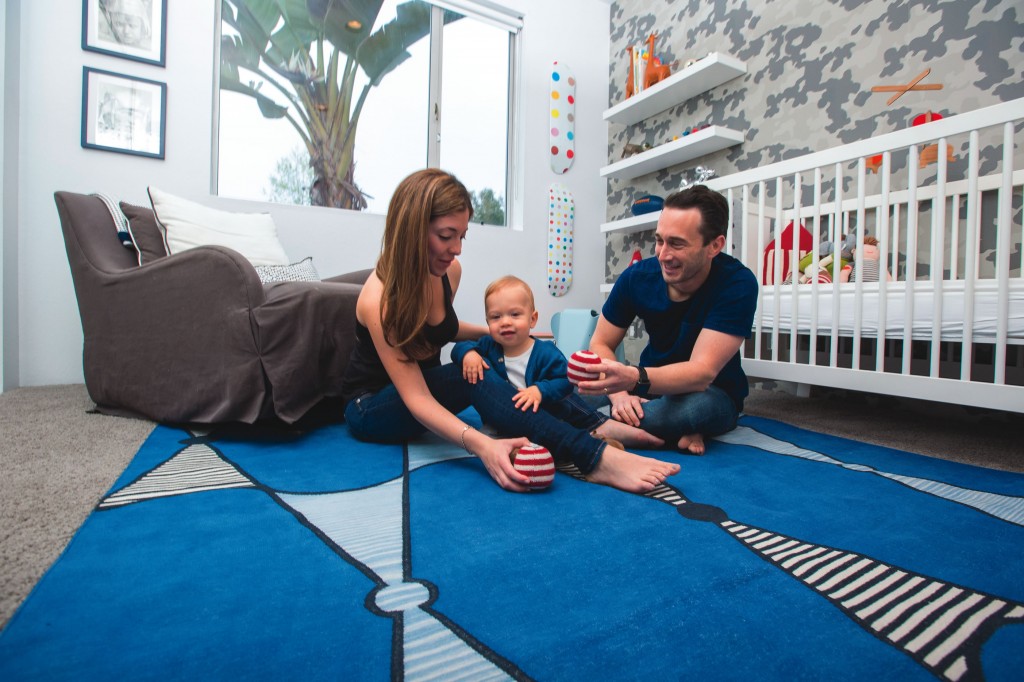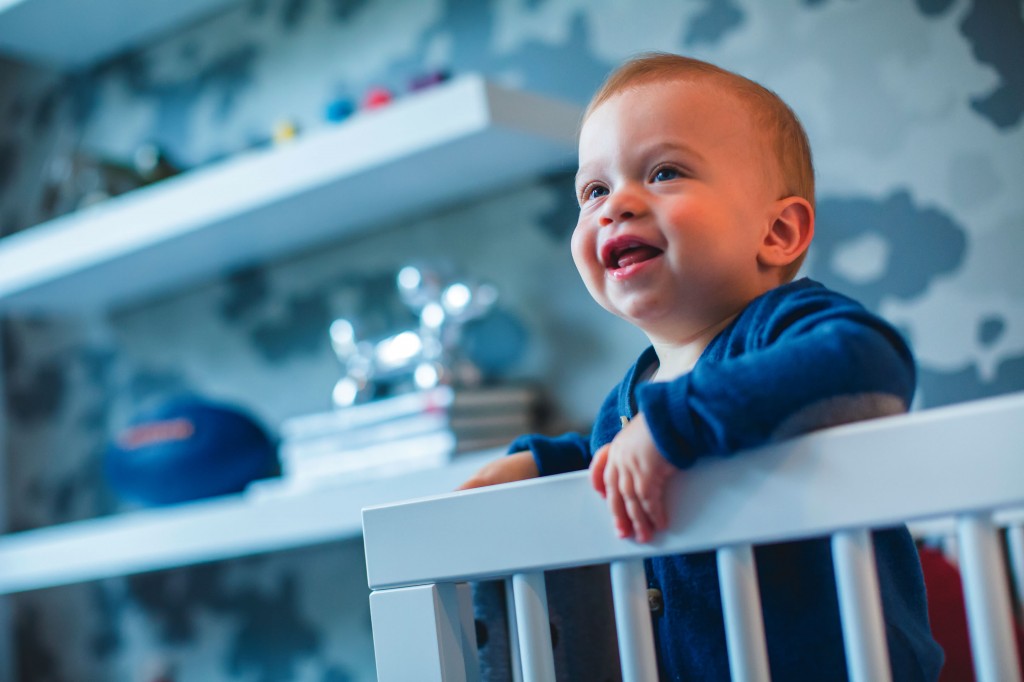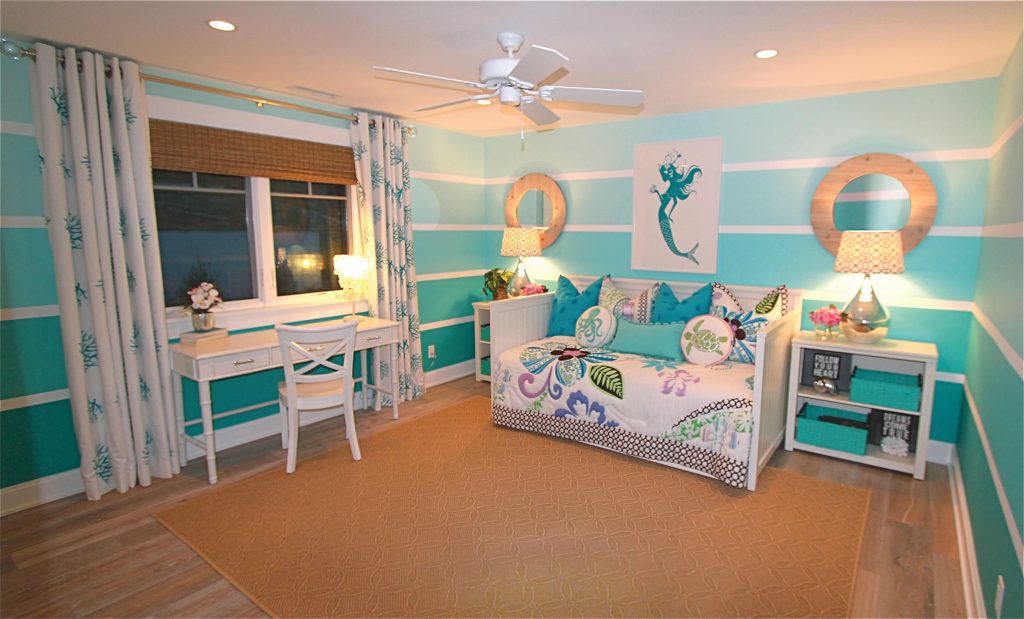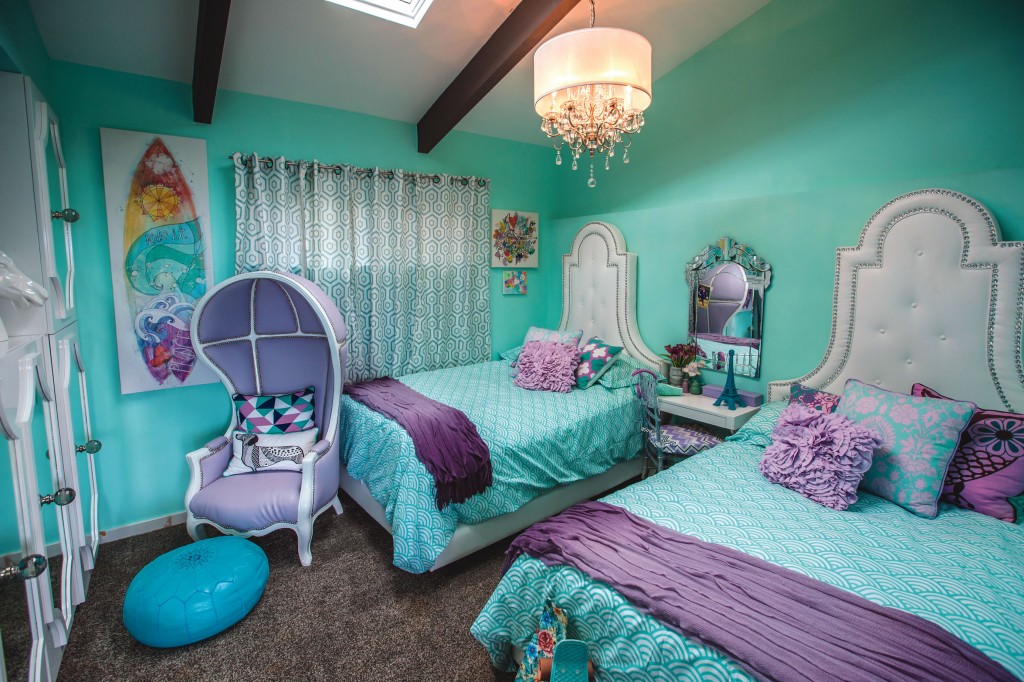Though they may be for little ones, these four kids’ spaces are big on style.
By Margie Monin Dombrowski
Children’s bedrooms can take on multiple personalities and the design options are endless, but the planning phase often leaves parents stumped. After all, when will your son outgrow that video game theme, and just how soon will your tween tire of today’s color scheme before she moves on to the next one? What suits your children now may be less relevant as the years go by, and the ability to design with this knowledge in mind is an acquired skill.
From whimsical wonderlands to sophisticated retreats, local designers share their thoughts on creating stylish spaces for children of all ages, along with tips on how to make their rooms grow with them.
Petite Sophisticate
A nursery doesn’t have to be filled with pastel colors and cartoon characters—it can take on a more grown-up and minimalist aesthetic. And, when you consider how many hours you’ll be spending there too, you may eventually realize you’re designing for yourself as much as for your bundle of joy.
According to Laguna-based interior designer Lisa Berman (her maiden name was Gutow), principal designer for Lisa Gutow Design, you can strike a perfect balance with carefully chosen furnishings, accessories and materials.
“Parents with new babies spend so many hours in their nursery,” she says. “There’s no reason it shouldn’t make you happy to spend time in there as well.”
In fact, Lisa and her husband Gary wanted to communicate a certain type of design and feeling into their son’s nursery after moving from a big city to Laguna Beach. “[We] wanted to capture some of that urban sophistication, but still keep it casual because they now live at the beach,” Lisa explains.

Inside the space, gray camouflage wallpaper takes center stage on a feature wall behind a modern, white crib. Add a graphic rug and a large “L” initial on the wall, and the room begins to reflect the kind of funky, metropolitan vibe that also makes for a soothing environment for a tot. Highlighting a statement feature such as a wallpaper print or rug pattern, Lisa says, is one simple way to make a bold impact in a space.
As a new parent, keeping everything in your baby’s nursery as healthy and toxin-free as possible becomes an important concern. That’s why Lisa committed to keeping virtually everything in the space eco-friendly, organic or nontoxic.
“There are so many details to think about—the glue, the paint, the dyes in the textiles, the foam in the chairs, everything,” she muses. “That was the biggest challenge, because there are so many things that people aren’t aware of that are toxic.”
Accordingly, the designer focused on sourcing stylish pieces that just so happen to be green: The crib sheets are organic, the dresser drawers are coated with a pop of nontoxic blue paint, the area rug is made with nontoxic dyes, and even the wallpaper glue is nontoxic. These details combine to create the functional yet eclectic look the couple was looking for without sacrificing style. Lisa adds, “We just tried to make it fun.”
Flexible Functionality

In this boy’s bedroom, designer Arianna Noppenberger selected furniture with added storage to make the most of the small space.
All an 11-year-old boy really needs in a bedroom is a place to sleep, an area to study and do homework, and space to play. When you’re working with a smaller room, every functional area and piece of furniture matters, so as soon as Arianna Noppenberger of Aria Design got to work on this compact space, her main priority became making the most of the room’s limited square footage.
“We shaped the room for any need,” she says. “Everything is moving, opening and closing.” The bed, for example, doesn’t take up much space in the room and serves a variety of purposes. With a pullout trundle bed underneath, it’s the perfect accessory for a sleepover; meanwhile, extra built-ins on the side of the bed maximize storage areas. A homework desk retracts into a cabinet space in the wall, opening up the area for play—and creating the kind of cool-kid trick an 11-year-old can appreciate. “You can get the most out of the space with custom built-ins,” Arianna continues. “[With kids,] the flexibility has to be there.”
Lighting is an often-overlooked aspect of designing children’s bedrooms that Arianna was sure to address. During the day, the space gets plenty of natural sunlight through a bank of windows along one wall, but the dark wood ceilings overhead could easily make it difficult to study at night. Arianna’s solution was to include recessed halogen light fixtures on dimmers that point toward the ceiling to indirectly illuminate the room. Table lamps also provide up-close task lighting so there’s never an excuse for unfinished homework.
The bedroom’s overall look is streamlined and subdued, which will make it easy to graduate to a more mature design scheme later on. Keeping materials like carpeting and dark wood uniformly neutral throughout the space makes the room more like a blank canvas that can be updated with accessories as time progresses—for now, however, a few bright accents work just fine. Wall shelves that currently display childhood trophies can later show off collections or other ephemera. By designing a space with options, Arianna adds, “You can create a room that grows with them.”
Tropical Hangout

Designing stylish, themed kids’ rooms calls for using a little restraint. For Nagwa Seif, owner of Nagwa Seif Interior Design in Irvine, pulling together this bedroom was a lesson in controlled creativity. “One of the first things [the clients] had asked for was the theme,” Nagwa says, adding that the clients’ 8-year-old daughter wanted mermaids integrated into the space. The designer’s challenge was giving the 8-year-old the themed room she wanted while creating a space that she can still enjoy in a few years.
Settling on an aqua color scheme for the ombre walls instantly satisfied the beachy request—plus, the shade is tame enough to withstand the tween and teen years. Coral printed drapes and a bamboo study desk that’s been painted white capture the desired coastal flair but are neutral enough to mix in with other decor styles. “In the pieces that you have to invest the most in, find something neutral,” Nagwa says. “It’s not going to go out of style or be anything she’ll outgrow.”
Furniture versatility is much more important in children’s bedrooms than in adult spaces because the selected pieces typically need to be multifunctional. “We opted to go with a daybed because with kids it’s not just about sleeping—it’s about playing and having their own space,” Nagwa says of the room’s furnishings. “We also thought it’d be perfect to use as a sofa so when she had her friends over they could use it to lounge or play.” Side tables with shelving provide spots to discreetly stash belongings in colored baskets that add vibrancy; the current baskets can also be swapped out with something new. “It’s all about versatility and having ways to change the room,” Nagwa adds.
Custom wall art the designer created by mounting and framing an aqua-colored decal of a mermaid silhouette corresponds with the theme without being overly kitschy. Best of all, removing the mermaid art is all it takes to switch the theme.
Nagwa’s advice for designing a children’s room is multidimensional: “Start with the color scheme, then figure out where you can take the least risks with the most expensive elements in the room,” she says. “Look for versatility in those pieces, and then decorate with everything else in a way that works with your child at that age—those things can be changed later on.”
Girly Glam
Sometimes, what a tween girl wants in a bedroom is a little bit of glamour. After outgrowing her previous bedroom style, 11-year-old Lola, daughter of Taryn and John Bernard, who own home a decor shop called ModShop by RoomService at SoCo in Costa Mesa, wanted to have a little more say in the colors and design. “The only thing she was very particular about was to not have pink in it,” Taryn says.
Working together, mom and daughter came up with a feminine yet sophisticated theme. “We chose a girly Hollywood Regency style, with a crystal chandelier, a bed accented with crystal nailhead trim and mirrors to reflect the light in the space,” Taryn says. “Lola is by no means a girly-girl; anyone who knows her knows she’s the perfect combination of princess and tomboy, preferring horse riding and hip-hop to your usual 11-year-old girl’s ballet, et cetera. This room was meant to be her special place to hang out with her friends and get away from her three brothers.”

The room’s former pink-and-yellow color scheme was replaced with aqua walls and accents of lavender for a more tween-appropriate look. “We travel often to places like the Caribbean and Mexico, where the ocean color is similar to the shade of paint we used, and Lola loves the water,” Taryn adds.
One wall features two Hollywood Regency-style beds with upholstered headboards, creating a striking focal point. As a unique solution, “We chose to squeeze two full-size beds into her room because she loves to have her friends over for sleepovers.”
Other eye-catching furniture pieces include the lavender balloon chair that’s popular with her friends and a small desk with a dainty mirror above. “This can serve double duty as a place to do homework and paint her fingernails.”
Major pieces such as the upholstered headboards and cabinetry are neutral in white so they’ll last longer, while fun accents like the custom painting of Lola and her dog, Buddy, and a graphic Buddy pillow add personality.
Designing for kids is tough, especially when their tastes are constantly changing, just like they are. However, with a few smart choices, you can give their spaces enduring style and functionality that will last a lifetime.





